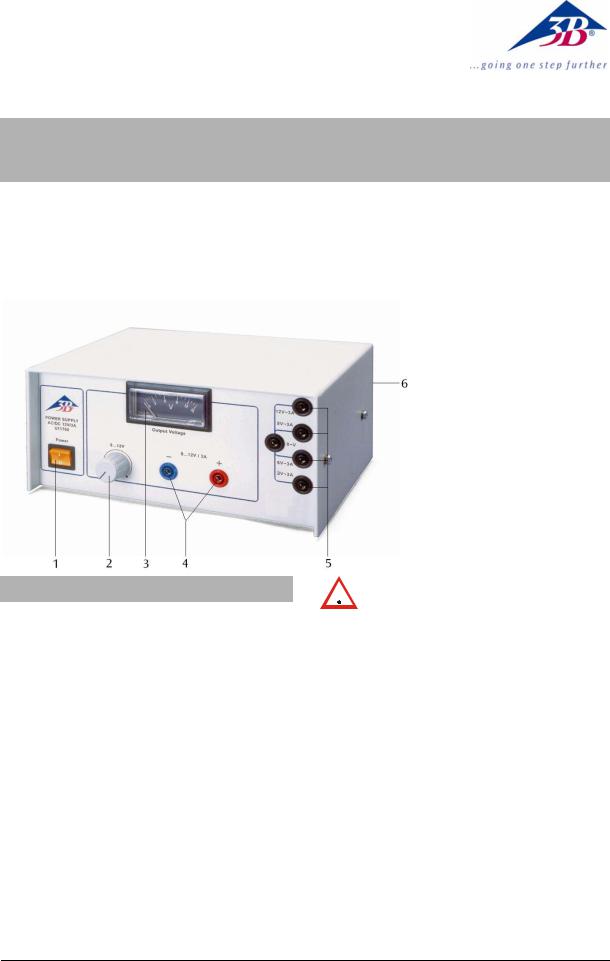3B Scientific AC-DC Power Supply User Manual

3B SCIENTIFIC® PHYSICS
AC/DC Power Supply, 12 V, 3A (115 V, 50/60 Hz) AC/DC Power Supply, 12 V, 3A (230 V, 50/60 Hz)
1002775 (115 V, 50/60 Hz)
1002776 (230 V, 50/60 Hz)
Instruction sheet
04/12 ALF
1 On/off switch
2 DC voltage adjustment knob
3 DC voltage display
4 DC output
5 AC constant voltage outputs
6 Fuse box (back of apparatus)
1. Safety instructions
The 12 V/3 A AC/DC power supply unit conforms to all safety regulations for electrical measuring, control, monitoring and laboratory equipment, as specified under DIN EN 61010, Section 1, and the equipment has been designed to meet protection class I. It is intended for operation in a dry environment, suitable for the operation of electrical equipment and systems.
Safe operation of the equipment is guaranteed, provided it is used correctly. However, there is no guarantee of safety if the equipment is used in an improper or careless manner.
If it may be assumed for any reason that nonhazardous operation will not be possible (e.g. visible damage), the equipment should be switched off immediately and secured against any unintended use.
In schools and other educational institutions, the operation of the AC/DC power supply unit must be supervised by qualified personnel.
 Caution: the low-voltage outputs of the power
Caution: the low-voltage outputs of the power
supply are not surge-proof if exposed to external voltages of more than 100 V with respect to earth.
•When using the equipment in conjunction with other power supplies, e.g. for operating electron tubes, be careful that no voltages in excess of 100 V with respect to earth are present at the outputs.
•Before using the AC/DC power supply unit for the first time, confirm that the specifications printed on the rear side of the housing are compatible with the local mains voltage.
•Before using the AC/DC power supply unit for the first time, check the housing and the mains lead for any damage. In the event of any malfunction/operational defect or visible damage, switch off the unit immediately and secure it against unintended use.
•The instrument may only be connected to the mains via a socket that has an earth connection.
1

•Before making any connections, check the experiment leads for damaged insulation and exposed wires.
•Replace a faulty fuse only with one matching the specifications stated at the rear of the housing.
•Disconnect the equipment from the mains before replacing a fuse.
•Never short the fuse or the fuse holder.
•Never cover the air vents in the housing. This is necessary in order to ensure sufficient circulation of air required for cooling the internal components of the equipment.
•The equipment may only be opened/repaired by qualified and trained personnel.
2. Description
The 12 V/3 A AC/DC power supply is characterised by its high voltage stabililty, low residual ripple and overload protection.
In the range from 0 to 12 V, it features one continuously regulated DC output and 4 constant AC voltage outputs (3 V, 6 V, 9 V and 12 V).
An analog meter displays the DC voltage. The voltage is floating and is tapped from the front sockets. It is galvanically isolated from the AC outputs.
The voltage outputs are safeguarded by semiconductor fuses (multifuses).
Only one AC output can be operated at a time.
Caution:
Connecting instruments with current outputs up to 5 A DC in series can be done without any difficulty. For instruments with current outputs over 5 A, a diode needs to be connected in parallel with the output sockets of each instrument for overload protection. The anode of this diode is connected to “-“, and the cathode to “+”. The diode has to be rated for the maximum load current.
The AC/DC power supply 1002775 is for operation with a mains voltage of 115 V (±10%), and the 1002776 unit is for operation with a mains voltage of 230 V (±10%).
3. Technical data
DC output |
|
Voltage: |
0 to 12 V, continuously |
|
variable |
Stability 0 … 100% load: ≤ 30 mV |
|
Residual ripple: |
≤ 3 mV rms. |
Current: |
3 A, up to 5 A max. for |
|
brief intervals |
Cut-out current: |
> 5 A |
AC output |
|
Voltage: |
3, 6, 9, 12 V |
Current: |
3 A |
Mains voltage: |
See back of instru- |
|
ment |
Operating temperature: |
0…40° C |
Storage temperature: |
-25…70° C |
Display: |
Analogue, class 2.5 |
Fuses: |
T 1 A primary, 5 semi- |
|
conductor fuses (multi- |
|
fuses) secondary |
Connections: |
4-mm safety sockets |
Dimensions: |
230x115x190 mm³ |
|
approx. |
Weight: |
5 kg approx. |
4.Operation
4.1Outputting DC voltage
•Set voltage adjustment knob to 0 (fully anticlockwise).
•Connect instrument to mains.
•Connect DC load to both output sockets (blue = minus, red = plus). The chassis is connected to the ground of the line input.
•Flip power switch up (power light is illuminated).
•Select desired voltage with the voltage regulator (which can be read on the voltage display).
4.2 Outputting AC voltage
The AC range offers preset constant voltage levels.
•Connect instrument to line voltage.
•Connect AC load to one of the AC outputs.
•Flip power switch up (power light is illuminated).
4.3 Changing fuses
•Disconnect the instrument from the mains. Pull out the the plug.
•Use a screwdriver to open the fuse box at the back of the instrument.
2
